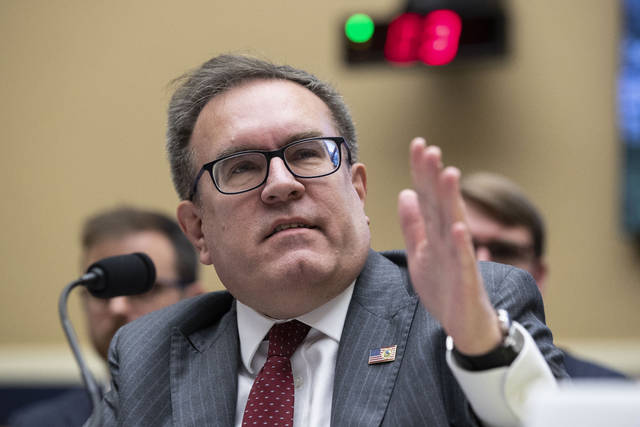https://naviga.triblive.com/opinion/michael-krancer-clarifications-to-epas-cost-benefit-analysis-will-protect-pa-s-environment-and-businesses/
Michael Krancer: Clarifications to EPA’s cost-benefit analysis will protect Pa.'s environment and businesses

Recent history in Pennsylvania has shown that it’s possible to grow our energy economy and make important environmental gains. During my time as secretary of our state’s Department of Environmental Protection, for example, Pennsylvania’s natural gas industry grew significantly, created unprecedented job growth and lowered costs for consumers, while harmful methane emissions dropped more than 75% over the past decade.
Historically the federal Environmental Protection Agency (EPA) has had an inconsistent track record when it comes to properly weighing the impact of its decisions the economy. In the past, EPA has regulated matters with inaccurate analysis of the supposed benefits of proposed regulation and insufficient or inaccurate analysis of the costs of its regulation. This problem has become particularly acute by associating so-called “co-benefits” or “ancillary benefits” to regulations which results in overstating public health benefits from a particular regulation. I have written, for example, of EPA water quality standards that impose extraordinary costs while creating minimal measurable environmental or public health gains.
The good news? Current EPA Administrator Andrew Wheeler is proposing to enact a serious cost-benefit analysis policy that objectively weighs the proposed benefits of environmental rules against the costs imposed. Not only will this stop EPA from imposing significant costs in exchange for negligible benefits, but it will also allow government and industry to focus investment where the greatest environmental benefits for the maximum number of people can be achieved.
There is little doubt about the heavy toll of the EPA rulemaking and the societal benefits that would be enjoyed using a rational cost-benefit analysis to proposed regulation. Consider that today, more than two-thirds of the costs imposed by significant federal regulations originate from EPA, especially from the complicated Clean Air Act. An enormous patchwork of federal regulations, much of which is overseen by the EPA, cost the American economy just shy of $2 trillion annually in direct costs, lost productivity, and higher prices according to the U.S. Chamber of Commerce. On top of that, a disproportionate amount of these costs are borne by small businesses with 50 or fewer workers.
Effective, objective cost-benefit analysis is supported by interests and policymakers from both sides of the political aisle. The National Association of Manufacturers and the American Chemistry Council have both endorsed this approach. Weighing costs against benefits when it comes to environmental rules has garnered momentum and consensus among the courts and policymakers, as well as from the public itself.
As former Obama White House official and Harvard environmental law scholar Cass Sunstein explains: “If the EPA actually followed it, it would make the air and water a lot cleaner — and save money in the process.”
The truth is that a cost-benefit rule is well grounded in law and policy. In 2015 the Supreme Court ruled that the EPA violates the law when it refuses to consider the cost of a rule. The Court’s opinion said that “[i]t is not rational…to impose billions of dollars in economic costs in return for a few dollars in health or environmental benefits.”
Cost-benefit analysis for regulations is a well-regarded method of developing effective and intelligent regulations with strong support across the political spectrum. President Reagan’s Executive Order 12866 directed all federal agencies to conduct cost-benefit analyses for new regulations. Presidents Clinton, Bush and Obama kept this order in force for nearly 40 years.
The problem at EPA has been inconsistent, and sometimes politicized, application of cost-benefits analysis. In addition, new technologies and information have made old rules obsolete and have obstructed better policy. President Trump’s Executive Order 13777 addresses this problem by ordering a thorough review of all regulations, allowing those regulations to be updated and improved.
The EPA is funded by public dollars; we all have a right to know the full costs and benefits of any rule imposed by any federal agency. A cost-benefit approach creates transparency and ensures regulatory decisions made by EPA are done with an eye toward sound policy. This is especially critical since EPA regulates sectors such as manufacturing, agriculture, and transportation, essential industries that provide millions of jobs and generates billions in revenue for states like Pennsylvania, providing essential services and products to all Americans.
Reforming EPA rules will particularly help Pennsylvania farmers hard hit by the Waters of the United States (WOTUS) rule, an EPA regulation that paid little attention to local costs. For years, EPA used the WOTUS rule to saddle farmers with red tape, and significant costs while not accounting for costs relative to benefits. A cost-benefit approach would allow farmers to make long-term decisions with greater confidence and clarity.
The public will ultimately have an opportunity to make its voice heard. All Pennsylvanians should do so, as a more sensible EPA rulemaking process helps our economy and the environment in the long run.
Michael Krancer is the former Pennsylvania secretary of environmental protection and chief judge of the Pennsylvania Environmental Hearing Board.
Copyright ©2025— Trib Total Media, LLC (TribLIVE.com)
